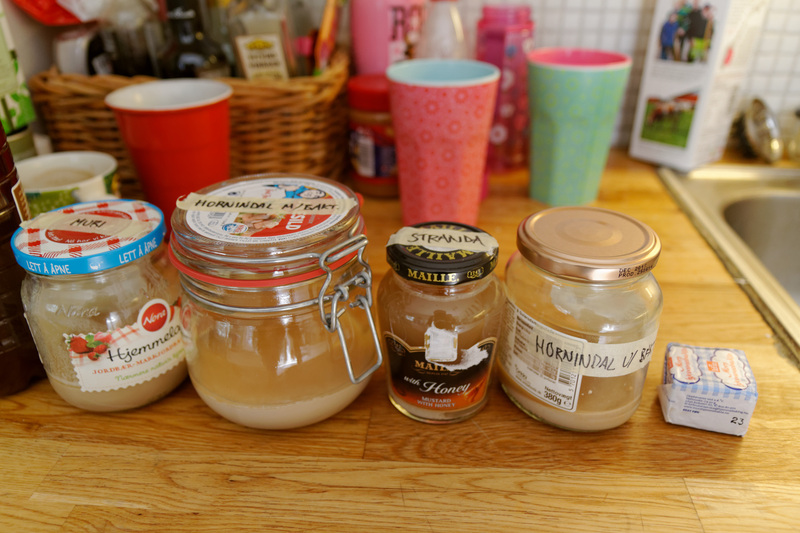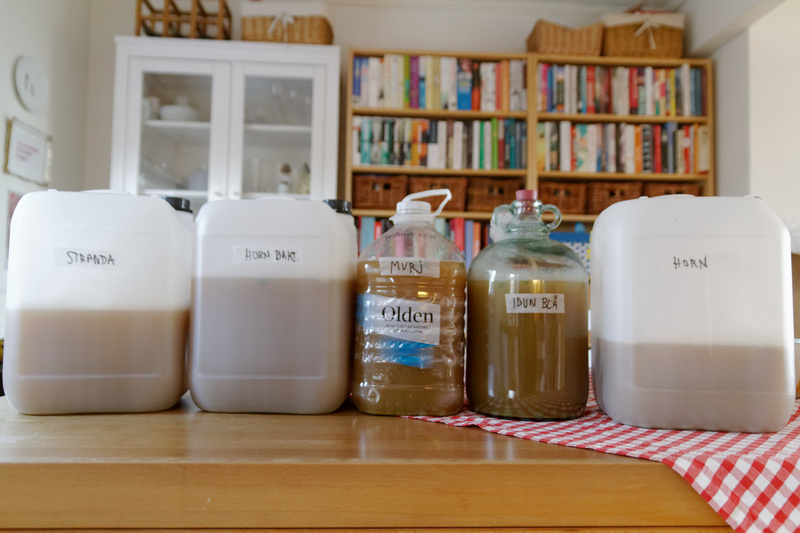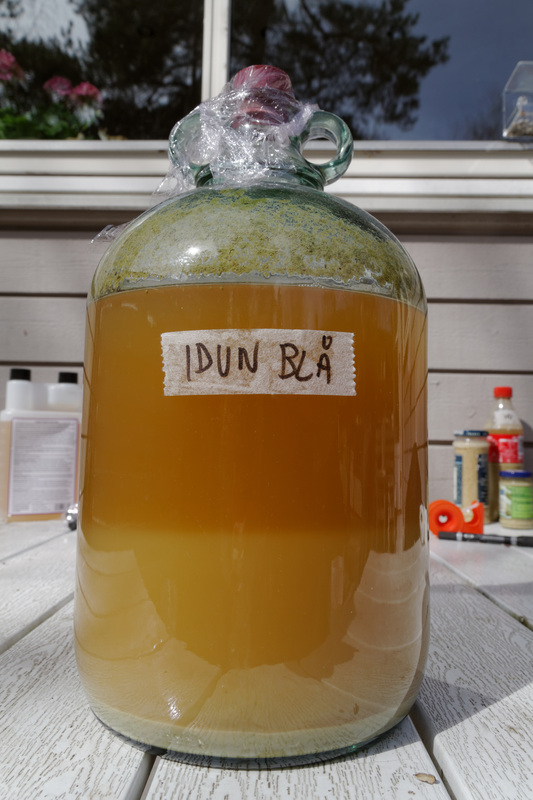Kveik testing

Bottle of Hornindal raw ale |
I got hold of a bottle of raw ale from Hornindal via contacts. I'd been warned earlier that kveik from Hornindal had gone bad, and made sour beer. And by this time I'd already had the brewer's kveik analyzed, and been told that it contained bacteria. So despite trudging a good distance across town and back again to get hold of the bottle, my expectations were quite low when I opened it at a small tasting at a friend's flat.
The shock was all the greater. The beer was magnificent! The aroma was like nothing I'd ever come across before, and literally so. It was deeply odd, and very hard to describe. The main things I picked out were a delicate fruity milk caramel and mushroom aroma, with herbal juniper notes. The aftertaste added traces of ash and citric acid. A very complex flavour, but soft, soft, soft in the mouth. Low carbonation, obviously. In short, an amazing beer.
One of my friends was sufficiently blown away to send me an SMS about the beer the next morning, where he mentioned how surprised he was to find that a raw ale from some random home brewer could turn out to be better than the top-notch Belgian beers we'd tasted the same evening. I can only agree.
So I tried to extract the recipe from the brewer via Facebook, and discovered that I didn't need anything special other than the kveik, which I already had. It proved difficult to get a detailed procedure, so some parts were not clear, but Geir Ove and I decided to attempt brewing it anyway.

Too much juniper |
By this time I had a good number of yeast cultures available, so we decided to split the 25-liter batch into several parts and ferment each part with a different culture so that we could compare them. The ones I chose were:
- Hornindal kveik. This is the same culture the original brewer used. Analysis has shown it to contain bacteria and no less than 8 separate yeast strains, some of which are not related to one another.
- Hornindal kveik without bacteria. Chris at NCYC kindly sent me this version so that I could send it back to the brewer to give him a "pure" kveik culture. We wanted to use this to see what difference the bacteria made, if any.
- Stranda kveik, being the kveik I got from Stein Langlo when we visited Stranda. Chris at NCYC had enormous difficulties reviving this one, but in the end a single strain had been willing to grow. Probably there had originally been more strains in the culture, but only one survived. (NCYC record.)
- Muri kveik. This is a kveik that was revived after being unused for 24 years. The (I think) son from the farm is a modern home brewer living in Oslo, and he now uses this revived strain in his own brewing. It's available from White Labs as WLP 6788 in Norway. Analysis indicates it consists of two related strains. (NCYC record.)
- Idun Blå. This is a bread yeast that's sold in Norwegian stores. Many of the farmhouse brewers have switched to using this yeast when they gave up their own strains, in large part because several decades ago this was the only yeast you could buy. I wanted to see how it compared to kveik.

The five cultures |
I'll pass over the recipe and the actual brewing, because as it turned out we didn't do it right. The beer we made was not horrible, but it was nowhere near as good as the original. Unfortunately, we don't know why, since the recipe we had was so incomplete. From talking to the brewer we know we used too much juniper. We probably also messed up the mashing, which is hard to avoid given that the brewer does not measure his mash temperature, so we were doing that part blind. And in a beer that's not boiled there is basically only mashing plus fermentation, so mashing becomes even more important than it usually is.
Anyway, after cooling we split the wort into five smaller containers, then pitched the yeast at 30C. We were told this is what the brewer does. That might not be ideal for the Stranda and Muri kveiks, which are probably used to temperatures 5-10C warmer, but it would have to do.

Five fermenters |
Then, a week later, we had the grand tasting. Despite the beer being nowhere near as good as the original. Now, another couple of weeks later, it's getting better, but it's still way off.
The biggest surprise was how different the five beers were. They might as well have been five completely different beers. I've had the Mikkeller yeast series, and those beers were far more similar to one another than these five. Which is kind of interesting. It makes you wonder how much yeast diversity was lost in the huge die-off of yeast cultures that happened in the 20th century.
I'll present the results in the order we tasted them:
- Stranda: Aroma of lemon, nuts, grain, and straw. A little acid. Not a bad beer, but not great, either.
- Idun Blå: Pear, other fruits, oily, peas. Overall this one felt a little "slack" and unfocused. Not the best.
- Hornindal: Several people went "hey? what?" when smelling this one. It wasn't the same as the original beer, but some of the same character could be recognized. Fruit, milky caramel, honey, mushroom. Really a unique aroma.
- Hornindal without bacteria: Weirdly, this one was completely different. It felt thinner in the mouth, and had more of a citrus character. The mushroom and milky caramel were gone.
- Muri: Earthy on the nose, fruity in the mouth. Rubber, sulphur. Thinner mouthfeel. Again not the best.
So, amazing as it might seem, the bacteria don't just make a big difference in the Hornindal kveik, but they actually seem to be what makes the beer so special. I'd really love to know what bacteria they are, but Chris at NCYC works with yeast only, so he doesn't have the equipment to determine it. I've now found some other researchers in Norway who I hope will look into that this autumn.
That Idun Blå should do relatively poorly is not surprising. That yeast isn't sold as a beer yeast, after all, even if it is also Saccharomyces cerevisiae.
The next step now is to figure out how to brew this beer right. I guess the only way to do that is to actually visit the brewer while he's brewing and see how he does it. Whether I can actually do that remains to be seen.

Not a great flocculator, the bread yeast |
Similar posts
Analysis of farmhouse yeast (kveik)
The Norwegian University of Science and Technology (NTNU) in Trondheim started doing research and courses on brewer's yeast a little over a year ago
Read | 2016-09-06 16:30
Kveik analysis report
One of my goals for the Norwegian farmhouse ale trip was to see if kveik (family yeast) still existed in Norway, and to get samples if possible
Read | 2014-09-26 08:11
Comments
Dave - 2015-05-05 21:05:54
Fascinating stuff. I wish you could visit the brewer with a film crew in tow! (Maybe time for a crowdfunding campaign? I'd chip in.)
Roar Sandodden - 2015-05-06 02:46:42
Great experiment, and wery useful for traditional brewers still looking for their lost yeast strain..
Lars Marius - 2015-05-06 02:47:01
@Dave: Thank you! So far I haven't been able to persuade the brewer to invite me when it's just me alone, so I think a film crew will have to wait. (But, yes, the traditional brewers would make great TV.)
eren - 2015-05-06 02:51:10
Amazing read. I hope you get to visit the brewer and give it another shot. Looking forward to reading the results!
Ron Kaufmann - 2015-05-10 11:28:53
Lars, I have not been able to view the photos in this post. They appear as broken hyperlinks. Is that on purpose?
Lars Marius - 2015-05-10 13:29:24
@Ron: Thank you for the heads-up! There has been a sysadmin screwup, committed by me. It's better now. I'll fix the rest as soon as I can.
James Thor - 2016-04-20 10:44:22
Lars - any further update on a recipe for this? Have you tried it again with better results?
James
Lars Marius Garshol - 2016-04-20 12:24:08
@James: Yes, I've visited the brewer and brewed with him. Recipe is now at http://www.garshol.priv.no/blog/342.html